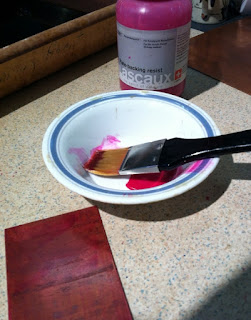I have plans to make some new etchings but first I had to make up some new etching solution. I use FeCl since it is not very toxic and doesn't require ventilation, something rather difficult to achieve in my studio. Still I use goggles and gloves to protect myself. I then add citric acid (from lemons) which speeds up the etching process on the copper plates. It's called the Edinburgh Etch. I had no plans to do etchings in my studio because of the nature of the chemicals involved but through research, I found some great substitutes. I ordered a small kit of products from Lascaux a few years ago and have found them quite affective! I am determined to go non-toxic. Here is a little demo that I worked on this week to test my new Edinburgh etch:
(I hope it makes sense.)
 |






You are lucky to use no-toxic products with a really interesting name !!
ReplyDeleteI'm not sure if they are from the caves of the Paleolithic Age but they have that nice French name!
ReplyDelete